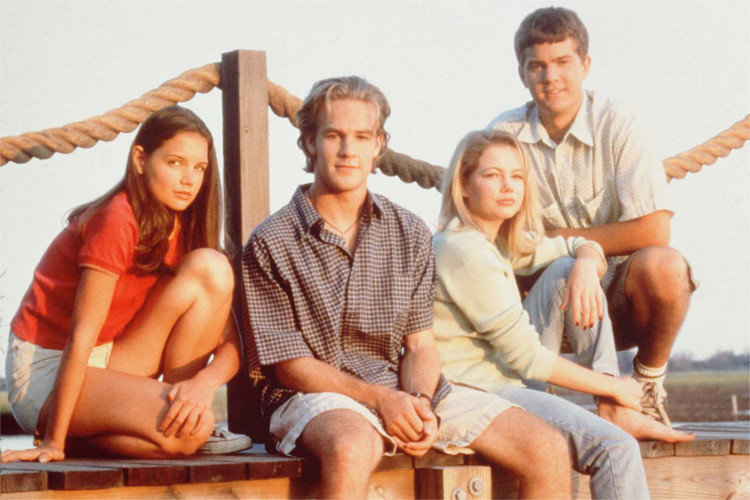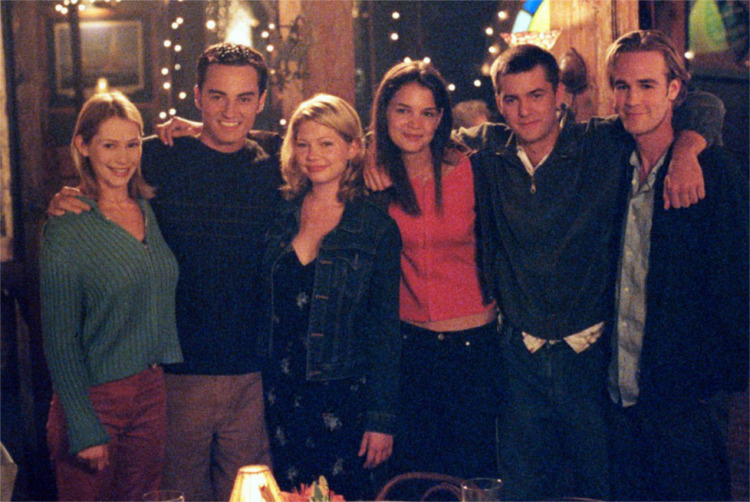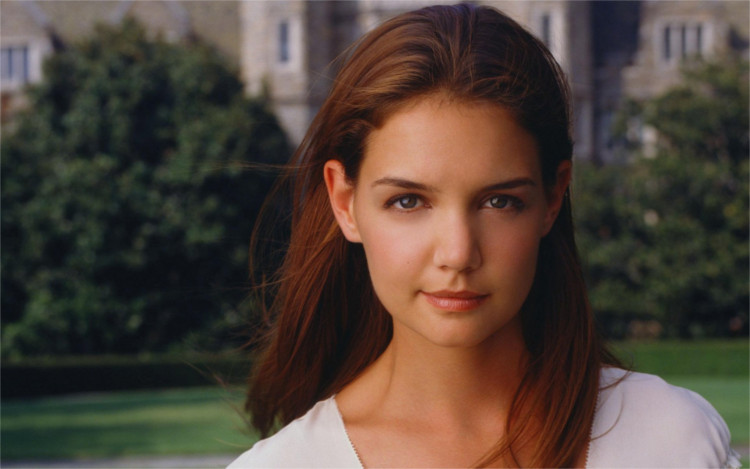TV Feature | Ultimate Teen Angst Drama Dawson’s Creek Turns 20
Come sit here by the (Kindle) fire, child, and let me tell you of a magical time back in the olden days. It was before your Snapchats and your Spotifying, before the words ‘problematic’ and ‘discourse’ and ‘intersectional’ escaped from college campuses, when the internet was in its infancy and television shows were things you watched on the actual television, according to the schedules set by the networks.
Let me tell you of the late 90s and the WB – the Warner Brothers television network (1995-2006) that brought us an era of teen-centric television like the world had never seen. The ‘teenager’ as a marketing category had existed since the mid-twentieth-century, although often seemed to be a particularly American phenomenon. Teen-centric movies hailed from Hollywood, and teen-focused shows (or rather ‘programmes’) in other countries, like Grange Hill (UK) and the various Degrassi series (Canada) were categorised as ‘children’s TV’, even though they often featured gritty content. It wasn’t until the 90s that we saw the beginning of teen TV proper.
By this I mean shows featuring teenagers, and centred round those teenagers, and actually aimed at teenagers (although watchable by an adult audience too). These were evening shows versus the daytime, after-school stuff that was suitable for younger kids too (think Saved By The Bell, California Dreams, Hang Time, etc) and only tackled ‘issues’ in ‘very special episodes’.

Beverly Hills 90210 (Fox, 1990-2000) was the quintessential teen soap, focusing on relatively privileged teens in California, while the short-lived My So-Called Life (ABC, 1994-95), starring a Claire Danes before she was best known for her Carrie-Mathison-cry-face, gave us something closer to ordinary suburbia and dramatic realism. By 1997, when Buffy the Vampire Slayer came along, the WB network noted its success and shifted their focus towards this teen audience. In Ireland and the UK, of course, who was showing what ‘abroad’ meant very little to us, but the teen shows that crossed the Atlantic were, particularly in the late 90s and early 00s, either from the WB originally or feasible because of its success.
The WB gave us, among other things, Popular (Ryan Murphy’s under-appreciated pre-Glee teen drama), Roswell (aliens), Charmed (witches), One Tree Hill (basketball and angst), Supernatural (two brothers fighting demons) and Smallville (teenage Superman) as well as family dramas with significant teen content like Gilmore Girls, Everwood, and 7th Heaven. Some of these hopped over to new network The CW (airing alongside that glamorous new show, Gossip Girl) after The WB’s closure, while others faded into semi-obscurity, particularly as streaming and boxsets became much more a part of our viewing habits.
The most iconic of these teen WB shows, however, was Dawson’s Creek (1998-2003). Twenty years ago, beautiful blonde Jen “I was sexualised way too young” Lindley, played by Michelle Williams, stepped out of a cab and into the lives of three small-town friends, and nothing was ever the same again. For movie-addict and aspiring filmmaker Dawson Leery (James Van Der Beek), creator Kevin Williamson’s semi-autobiographical protagonist, she was his first girlfriend (and later first lover). For awkward tomboy Joey Potter (Katie Holmes), Jen was the catalyst in Joey coming to terms with her more-than-platonic feelings for her childhood best friend. And for Pacey Witter (Joshua Jackson) – well, okay, he was busy telling the new hot teacher at school that he was “the best sex you’ll never have”, a spectacularly confident move from a fifteen-year-old boy and only plausible given that Jackson, like many actors playing teens, was several years older at the time. (Pop-culture analysis resource TVTropes uses the term ‘Dawson Casting’ for this trend, given that the show was particularly fond of it, with teen characters often portrayed by actors in their late twenties.)

Dawson’s Creek appealed from the start because it was, like My So-Called Life, a small-town drama where not everyone was fabulously wealthy and glamorous (even if they were all terribly attractive). Fictional Capeside, Massachusetts (filmed in Wilmington, North Carolina) was the kind of place you might actually live as a normal person. The show ventured into horror occasionally, unsurprising given that Williamson was also starting work on the Scream franchise at the time, but mostly its concern was simple: the feelings. The angst. The woes of being an adolescent and figuring out your identity and struggling with changing bodies and friendships and oh, of course, sex. The pilot opens with Joey and Dawson sharing a bed, Joey all-too-aware of how things are changing (“our emerging hormones are destined to alter our relationship”) while the romantic, innocent Dawson remains convinced that “all of the answers to life’s questions can be found in a Spielberg film”.
Dawson’s Creek deliberately gave these teenagers a heightened vocabulary to accurately express their burgeoning feelings and frustrations. (As author Shirley-Anne Macmillan puts it, “they talked in a way that NO TEENAGER EVER TALKS EVER, except maybe Judith Butler as a teen.”) Even today, insightful teenagers might manage a Capeside-esque monologue on Tumblr but not so much in real life. These hyper-articulate adolescents didn’t sound like ‘real’ teenagers except they did – because the emotional truths rang true.
The drama, too, was a heightened version of ‘typical’ or at least plausible high-school (and later college) events – dealing with your older sister’s pregnancy, your deadbeat dad, your ambition to get to college despite being from the wrong side of the tracks (Joey); coping with cracks in your parents’ marriage and realising they too were human, and that not everything in life could be solved by turning to a blockbuster movie (Dawson); desperately trying to ‘make good’ despite everyone thinking you were a loser or otherwise damaged (both Pacey and Jen). Later seasons gave us siblings Andie and Jack, who offered up then-ground-breaking portrayals of mental illness and coming out, respectively.

Romances blossomed and faded, with the ‘will they/won’t they’ ballad of Dawson and Joey giving way to the fan-preferred Pacey and Joey pairing over time, and with the other regulars Jen, Andie, Jack and later Audrey finding love and lust both in and out of this close-knit group. Many of the temporary love interests were guest stars from other 90s and 00s teen dramas – Scott Foley (Felicity), Jason Behr (Roswell), Rachael Leigh Cook (She’s All That), Brittany Daniel and Ryan Bittle (Sweet Valley High), Bianca Lawson and Adam Kaufman (Buffy the Vampire Slayer), Chad Michael Murray (One Tree Hill) and Jensen Ackles (Supernatural) among them. But we knew it would all come back to the central characters, and particularly that core trio – Joey’s ‘final choice’ is revealed only in the last minute of the finale, and hit our screens before we were sick of teenage love triangles. It didn’t feel gimmicky then. It felt honest.
Even with the occasional nods to the supernatural in the early scary episodes (which faded away once Williamson left the show) there was always either a rational explanation or else a sense that you were being asked to indulge the show, just for this episode, to play along. Dawson’s Creek knew its place within popular culture and didn’t hesitate to tap at the fourth wall when it suited, including occasional references to other TV shows on the network and episodes that borrowed their plot – often explicitly acknowledged by Dawson – from classic movies (Season one’s ‘Detention’ is The Breakfast Club, for example). The early days of Dawson and Joey’s romantic relationship are re-enacted twice on screen throughout the series – once as a student film Dawson makes, and again as part of his teen drama show The Creek (which smashes that fourth wall to pieces). We were constantly reminded that it was a story, but also reminded of the importance of telling, and listening to, and reading, and watching stories. It’s telling that as Joey surpassed Dawson as the central character (she is the only one to appear in every single episode), she too becomes more interested in stories, with an interest in art giving way to a passion for writing that leads to a career in publishing by the series finale.

Twenty years later, it still holds up as being a more authentic teen drama than more recent glossy shows (The O.C. as well as the aforementioned Gossip Girl are both closer to 90210 – which itself was rebooted in 2008 – levels of privilege). As of November 2017 it has been available on All 4’s streaming service, with many of the original music choices replaced for copyright reasons (as was the case with the video/DVD releases), but many Creek aficionados have rewatched the series multiple times since its finale in 2003. Writers and twitter users Louise Bruton and Ciara Smyth both watched the show when it originally aired in Ireland on RTE2 (during its ‘Network 2’ days), even though, as Bruton notes, much of it went over her head at the time, aimed at her four-years-older sister than herself. Smyth echoes that feeling: “As a teen, I was definitely scundered by all the riding . . . I remember strongly being really embarrassed at the scene where Pacey asks Joey if she had an orgasm because he didn’t use the word, and I didn’t know exactly what he meant, but I knew it was ride-related – and my parents were in the room.”
Many of us will be grateful that Joey’s enquiry in the pilot about how often Dawson “walked his dog” went over our heads at the time. But rewatching also offers up – as with many shows – both pleasures and moments of ‘oh dear’. There’s a delight in seeing Jane Lynch (who guest stars in almost every significant show of the 90s and 00s) in her pre-Sue Sylvester days, as Pacey’s mother, or watching Rizzoli and Isles’s Sasha Alexander as Pacey’s sister and Dawson’s love interest. The music, even though much of it has been replaced from the original broadcasts, still recalls that time in your adolescence where everything important has a soundtrack and a single song could either make your day or break your heart.
And there is, too, the cringing at some of the attempts to be too cool and super-relevant (Jack Osbourne’s cameo at the height of The Osbournes mania springs to mind), or at the buying into the convention of TV shows at the time: you simply must have musical guest appearances from hip, cool bands. The backdoor pilot for boarding-school drama Young Americans featuring Pacey’s never-before-mentioned childhood friend also deserves to be mocked.
Inevitably, though, the aspect of the show that comes off worst nowadays is the titular character, Dawson Leery (you can save your ‘Pacey Witter is problematic’ thinkpieces for at least another decade, please), even though as early as season three (not coincidentally the first season without Williamson) he was already the least favourite within fandom. The end of this season gives us Dawson’s infamous, meme-worthy ugly-cry-face while Pacey and Joey go off together on the good boat ‘True Love’ (please insert your own ‘shipping’ pun here). Dawson has, as Smyth puts it, a “classic Nice Guy complex”, viewing himself as a martyr to other people’s happiness and really being a “whiny self-absorbed baby”.

Bruton agrees, noting, “No one should ever root for Dawson Leery”, citing in particular his slut-shaming of Jen and the way that “he acts like he owns Joey” – not to mention being a “terrible director”. Dawson is the Ross Geller of Capeside: even viewers who liked him on the first viewing will now find much of his behaviour creepy and entitled. (Actor James Van Der Beek is, endearingly, not at all precious about the role, and spends a great deal of time poking fun at himself these days.) Unlike Ross, however, he doesn’t get the girl at the end, and the fact that the characters are 15-20 during the show (except in the series finale) means that youthful idiocy and narcissism mitigate an awful lot of the behaviour. Despite the big words and complicated sentences, these were still very much young people making mistakes and figuring things out.
There are other elements that strike you when you revisit the series: why did Joey become so Mary-Sue-like in later seasons? Why did Andie have to leave? How awesome was that genuinely-platonic friendship between Jen and Jack, anyway? How dodgy was Ms Jacobs, really? Whatever happened to Eve (though bonus points for referencing her in the last episode)? How many times can you use the word ‘soulmate’ unironically? How unrealistic (and disheartening) is that series finale where everyone seems to be super-successful at age twenty-five (unless they are being mercilessly killed off)? But ultimately it still works, even as technology and society have marched on; ultimately it is still about what it means to grow up and to have a lot of feelings (and to then overthink them).
If you, like that visiting student in Mean Girls, “just have a lot of feelings”, the show will speak to you; if you, like many people under thirty-five, are faced with bleak economic realities and an extended adolescence because the traditional markers of adulthood are no longer viable, the show is still deeply relevant. Actors speak of gathering all the emotional experience they need to draw on by age twenty; young adult novels are now read by far more people over eighteen than under. The things that we begin facing in our teenage years are many of the things that we grapple with for the rest of our lives. And if you’d like some super-verbose fictional teens portrayed by twentysomething actors to elaborate on this, Dawson’s Creek is there for you as the ultimate teen angst drama: 20 but not quite feeling it, as so many of us have been.

